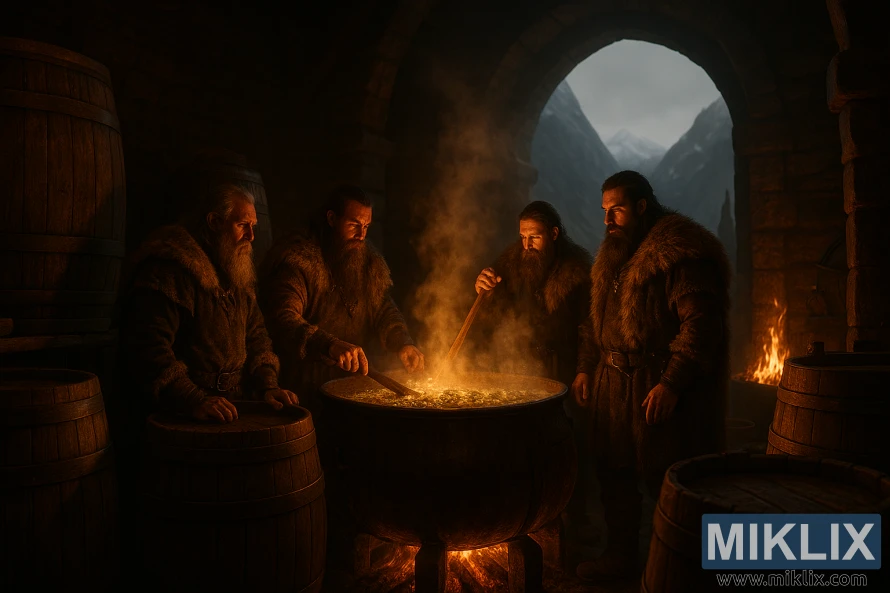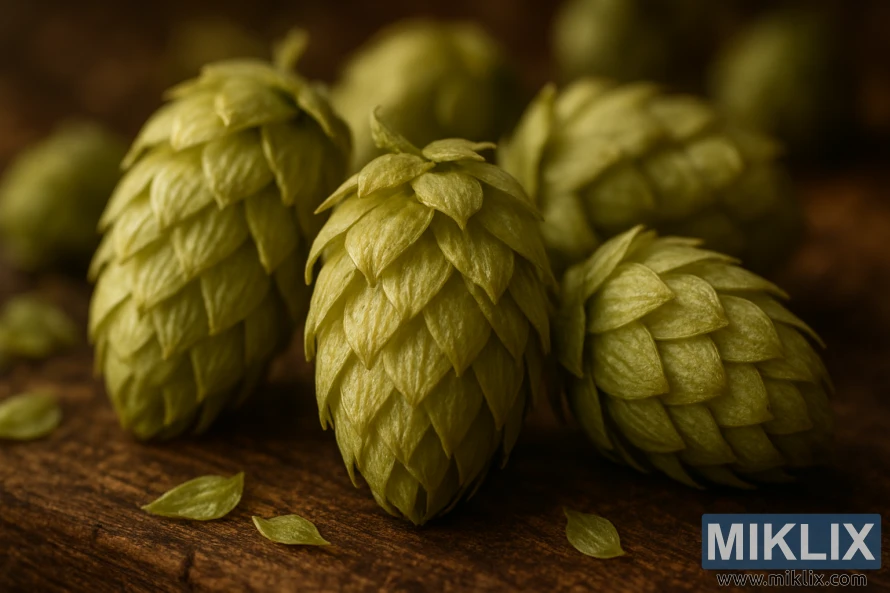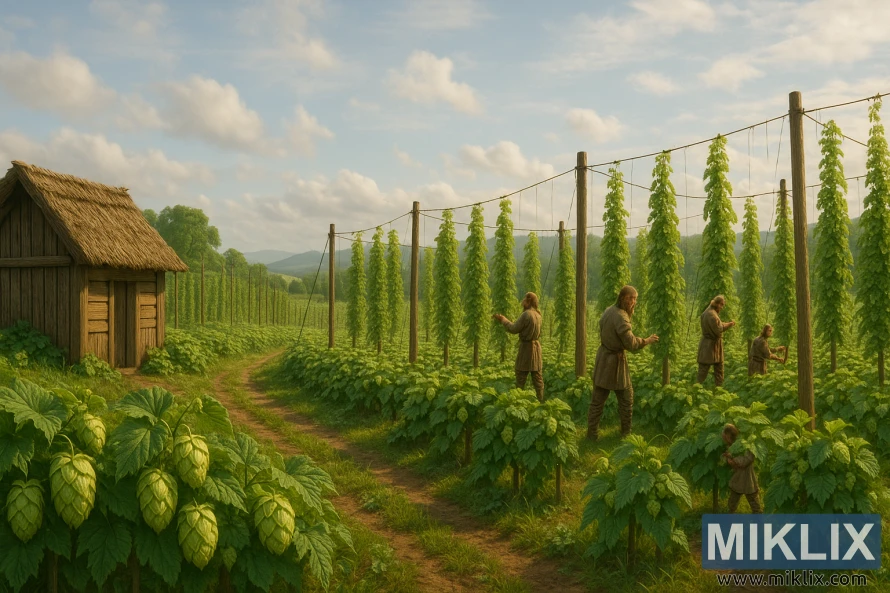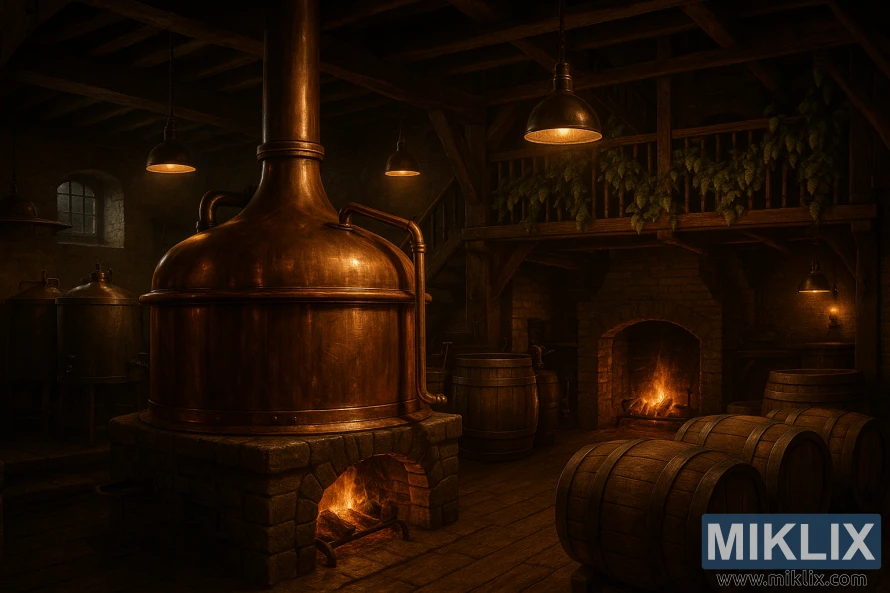Hops in Beer Brewing: Viking
Published: August 5, 2025 at 2:18:33 PM UTC
Brewing with Viking Hops is a tribute to Norse brewing traditions that span centuries. These aroma hops from Great Britain bring a unique flavor and moderate alpha acid content. This makes them perfect for balancing bitterness and aroma in beers. The historical brewing methods of Viking brewers are reflected in the use of these hops. They add depth and complexity to the brewing process. By using Viking Hops in modern brewing, brewers honor the past while crafting innovative beers.

Key Takeaways
- Viking Hops are an aroma hop variety from Great Britain.
- They have a moderate alpha acid content of around 9%.
- Viking Hops are used to balance bitterness and aroma in beers.
- Norse brewing traditions date back centuries.
- Historical brewing methods are relevant today.
- Viking Hops add depth and complexity to brewing.
The Historical Significance of Viking Hops
To grasp the historical importance of Viking Hops, we must explore ancient brewing techniques. These hops were more than just an ingredient; they were essential in Norse brewing traditions that span centuries.
The Vikings introduced various grains, including Bere, to Britain in the 8th century. Bere, a specific grain, was used for malting and brewing. This laid the foundation for the beers that became emblematic of Viking brewing.
The historical importance of Viking Hops can be seen in several areas:
- The introduction of new hop varieties used in Viking brewing.
- The role of Viking Hops in creating unique flavor and aroma profiles in Viking beers.
- The influence of Viking brewing methods on modern historical brewing practices.
Viking Hops gave Viking beers their distinct character, setting them apart from other brewing traditions. The use of these hops in historical brewing methods showcases Viking brewers' resourcefulness and their grasp of available ingredients.
By delving into the historical context of Viking Hops, today's brewers can appreciate the traditional brewing practices that shaped modern beer brewing. The legacy of Viking Hops continues to inspire brewers, whether they aim to recreate historical beer styles or innovate with ancient techniques.
Understanding Viking Hops and Their Characteristics
For brewers eager to explore new recipes, grasping Viking Hops' properties is key. These hops stand out due to their distinct chemical makeup and flavor profile. They bring a valuable dimension to a wide range of beer styles.
Viking Hops boast a moderate alpha acid content, which enhances their bitterness and stability in beer. Their taste is often noted as earthy and herbal, with hints of spice and fruit. This complexity enriches the brews they are added to.
The techniques used in brewing with Viking Hops greatly influence the outcome. For example, the timing of hop addition can highlight different facets of their flavor. Early additions tend to boost bitterness, while later additions amplify aroma and taste.
Integrating Viking Hops into brewing requires a thoughtful approach to their interaction with other ingredients. Their unique traits make them adaptable to various hop varieties and brewing methods. This versatility allows for the crafting of diverse beer styles.
- Viking Hops offer a distinct flavor profile that is earthy and herbal.
- Their moderate alpha acid content contributes to bitterness and beer stability.
- Brewing techniques, such as the timing of hop addition, can significantly impact the final flavor and aroma.
By mastering the characteristics of Viking Hops, brewers can craft complex and captivating beers. These beers showcase the unique qualities of this hop variety, engaging the palate and leaving a lasting impression.

The Unique Chemical Composition of Viking Hops
Viking Hops have a distinct chemical makeup, making them versatile in brewing. Their moderate alpha acid content, around 9%, offers a balanced bitterness. This balance is perfect for a wide range of beer styles.
The alpha acid content in hops is key to beer bitterness. Viking Hops provide a balanced bitterness, neither too harsh nor too mild. This balance is vital for creating complex flavors without overpowering other ingredients.
Hops' chemical composition greatly impacts a beer's flavor, aroma, and bitterness. Viking Hops are no exception. Their unique makeup makes them valuable in various brewing techniques. By using Viking Hops, brewers can achieve a desired balance of flavors and bitterness, improving their beers' quality.
Using Viking Hops adds depth to a beer's flavor profile and character. Their moderate alpha acid content is ideal for brewers aiming to create traditional styles with a modern twist.
Growing Regions and Cultivation Methods
Viking Hops thrive in Northern Europe's climate and soil. The UK, with its cool and temperate climate, stands out as a key region for their cultivation.
Farmers in these areas pay close attention to climate and soil. They use traditional farming methods, passed down through generations.
The ideal conditions for Viking Hops include:
- Cool and temperate climates
- Well-drained soil
- Adequate moisture levels
Knowing these conditions is vital for brewers seeking high-quality Viking Hops. The unique traits of Viking Hops are shaped by their growing regions and cultivation methods.
By understanding the specific growing regions and cultivation methods, brewers can appreciate Viking Hops' heritage and quality. This enhances their brewing practices.

Comparing Viking Hops to Modern Varieties
Viking Hops stand out with their unique flavor profile, differing from modern hop varieties. Modern hops are often bred for intense bitterness and aroma. In contrast, Viking Hops offer a balanced and subtle taste, perfect for traditional brewing.
The aroma of Viking Hops is also noteworthy. They have a nuanced and complex scent, unlike some modern varieties that can be overpowering. This makes them ideal for brewers aiming to craft beers with rich, balanced flavors.
Comparing Viking Hops to modern varieties reveals several key differences. Modern hops typically have higher alpha acid content, ideal for beers needing strong bitterness. Viking Hops, with their balanced alpha acid profile, are suitable for a broader range of beer styles.
- Viking Hops offer a subtle flavor profile.
- Modern hop varieties are often more intense.
- Viking Hops are ideal for traditional brewing methods.
In conclusion, Viking Hops offer brewers a unique alternative to modern varieties. They allow for experimentation with new flavors and aromas. By understanding Viking Hops' characteristics, brewers can craft a variety of beer styles that highlight these ancient hops' distinct qualities.
Preparing Your Brewery for Viking Hops
To prepare your brewery for Viking Hops, you must grasp the traditional methods and tools of Viking brewers. Achieving the authentic flavors of Viking-era beers requires adapting your equipment and ingredients to historical standards.
Choosing the right equipment is a critical step. Viking brewers often used wooden vessels. These can add unique flavors to your beer, boosting its authenticity.
The selection of ingredients is also vital. Viking brewers favored grains like barley and rye, malted locally. Using these traditional grains and malting methods can enhance your beer's Viking authenticity.
- Use wooden vessels or other traditional brewing equipment to impart unique flavors.
- Select grains that were commonly used in Viking-era brewing, such as barley and rye.
- Consider traditional malting techniques to enhance the authenticity of your beer.
By combining the right equipment and ingredients with traditional brewing methods, brewers can craft beers that honor the Viking brewing tradition. This approach not only enriches the beer's flavor and authenticity but also offers a unique selling point for craft breweries aiming to differentiate themselves in a competitive market.

Best Practices for Viking Hop Addition
The art of brewing with Viking Hops demands a deep understanding of optimal hop addition rates and timing. Achieving a balanced flavor profile that highlights Viking Hops' unique characteristics is possible with this knowledge. It's about mastering the elements that make a beer truly stand out.
Viking Hops offer a distinct flavor and aroma, perfect for crafting complex and engaging beers. To effectively utilize these hops, brewers must consider the timing of their additions. Hops added early in the boil contribute to bitterness, while those added later enhance flavor and aroma.
When brewing with Viking Hops, a mix of bittering, flavor, and aroma additions is common. Bittering hops are added at the boil's start, while flavor and aroma hops are added towards the end. The timing varies based on the beer style and desired flavor.
- Early boil additions (0-15 minutes) for bitterness
- Late boil additions (15-60 minutes) for flavor
- Whirlpool or dry hop additions for aroma
Understanding the optimal hop addition rates is key. Too many hops can unbalance the flavor, while too few can make the beer lack depth. The goal is to find a balance that complements the other ingredients.
Techniques like dry hopping and late hop additions can enhance Viking Hops' flavor and aroma. By experimenting with different techniques and hop rates, brewers can create a variety of beer styles. This showcases Viking Hops' versatility.
In conclusion, the best practices for Viking Hop addition involve careful consideration of hop rates and timing. By mastering these elements and experimenting with brewing techniques, brewers can unlock Viking Hops' full flavor. This leads to the creation of exceptional beers.
Creating Traditional Viking Beer Styles
To recreate Viking-era beers, one must dive deep into historical brewing techniques and ingredients. These beers were cloudy, tart, and full of flavor, thanks to local ingredients and simple equipment. This approach resulted in unique brews.
Brewers aiming for authenticity must learn about Viking-era ingredients and methods. Viking Hops, a key ingredient, gave these beers a distinct flavor and aroma. Understanding this is essential for creating true Viking beers.
Viking beer recipes often combined grains like barley, rye, and oats. These grains were malted over an open flame, adding a smoky taste. The brewing process involved boiling grains in water, cooling it, then adding hops and yeast.
The brewing techniques were simple yet labor-intensive. Beers were brewed in large cauldrons over fires. The fermentation process relied on wild yeast and bacteria, making it spontaneous.
Traditional Viking beers are known for their:
- Cloudy appearance from unfiltered brewing
- Tart or sour taste from wild yeast and bacteria
- Robust, full-bodied flavor
By adopting these traditional practices, modern brewers can craft authentic Viking beers. These beers highlight the unique qualities of Viking Hops and other traditional ingredients.

Modern Craft Beer Applications
Modern craft beer is evolving with the introduction of Viking Hops in various styles. These hops are transforming pale ales and IPAs into unique, flavorful brews. This shift is redefining the craft beer landscape.
Viking Hops stand out for their distinct flavor, making them a favorite among innovative brewers. By mastering the use of these hops, brewers can craft exceptional beers. This knowledge is key to producing high-quality craft beers.
Craft brewers are now experimenting with Viking Hops across different beer styles. This experimentation leads to complex, balanced flavors. For instance, Viking Hops in pale ales introduce a subtle bitterness and fruity notes, elevating the drinking experience.
- Viking Hops can be used to create a range of beer styles, from hoppy IPAs to crisp pale ales.
- The unique flavor profile of Viking Hops adds depth and complexity to craft beers.
- Brewers can experiment with different hop addition techniques to optimize the flavor and aroma of their beers.
By harnessing the unique qualities of Viking Hops, brewers can innovate within the craft beer genre. This innovation leads to the creation of high-quality, diverse beers that cater to a broad audience.
Common Challenges When Brewing with Viking Hops
Viking Hops pose several hurdles for brewers, including the quest for the perfect flavor and aroma. The main obstacle is grasping the unique traits of Viking Hops and their interaction with other brewing components.
The distinct chemical makeup of Viking Hops can cause brewing process variations. Their alpha acid content and essential oils greatly influence the beer's flavor and aroma.
To conquer these challenges, brewers must meticulously plan the timing and quantity of Viking Hop additions. This might require adjusting the brewing schedule to match the special properties of these hops.
- Monitor the alpha acid content to achieve the desired bitterness level.
- Adjust the dry-hopping schedule to enhance the aroma characteristics.
- Experiment with different Viking Hop varieties to find the optimal flavor profile.
By grasping these challenges and tailoring brewing methods, brewers can successfully integrate Viking Hops into their recipes. This results in unique and flavorful beers that highlight the ancient hop variety's characteristics.
Storage and Preservation Methods
To preserve the distinct characteristics of Viking Hops, brewers must employ careful storage and handling methods. The unique flavor and aroma compounds found in these hops can be easily degraded if not stored properly.
Effective storage begins with keeping Viking Hops in a cool, dry environment, away from direct sunlight and heat sources. This helps to slow down the degradation process of the delicate alpha acids and essential oils.
- Storing them in airtight containers to prevent exposure to air and moisture.
- Keeping the containers in a refrigerator or freezer to maintain a consistent, cool temperature.
- Minimizing the hops' exposure to light, as it can cause the breakdown of sensitive compounds.
By following these storage and handling guidelines, brewers can help ensure that their Viking Hops remain fresh. They retain their unique flavor and aroma characteristics. This ultimately results in a higher quality beer.
Quality Control and Testing
To ensure consistency and quality in their beers, brewers must conduct detailed hop analysis and brewing trials. Viking Hops, with their distinct chemical makeup, demand precise analysis. This is to ensure the final product meets the desired standards.
Regular hop analysis is critical for several reasons. It helps brewers understand the alpha acid content, essential for achieving the right bitterness level. It also provides insights into the hop's aroma and flavor profiles. This information enables brewers to make informed decisions about when to add hops during brewing.
Brewing trials are another vital part of quality control when using Viking Hops. By conducting small-scale brewing trials, brewers can test the hop's performance in different beer recipes and under various brewing conditions. This helps identify any issues and allows for necessary adjustments before scaling up production.
Some key aspects to focus on during brewing trials include:
- Hop addition timing and techniques
- Hop quantity and its impact on flavor and aroma
- Interaction between Viking Hops and other ingredients
By combining thorough hop analysis with rigorous brewing trials, brewers can ensure their beers brewed with Viking Hops are of the highest quality and consistency. This attention to detail is what distinguishes exceptional brews from the rest.
Sourcing Authentic Viking Hops
The search for authentic Viking Hops is a daunting task, yet it's critical for traditional brewing. Brewers aiming to craft beers that honor Viking traditions must find high-quality, genuine Viking Hops.
For this, brewers can rely on specialized hop suppliers and distributors. These entities concentrate on traditional and heritage hop varieties. They possess a profound understanding of Viking Hops' historical context and characteristics. This ensures brewers obtain hops that are as authentic as possible.
- The supplier's reputation and experience with heritage hop varieties
- The cultivation methods used to grow the hops
- The quality control measures in place to ensure the hops meet high standards
- The availability of documentation or certification that verifies the hops' authenticity
Collaborating with esteemed suppliers and distributors guarantees brewers access to authentic Viking Hops. This not only boosts the beer's flavor and aroma but also preserves Viking-era brewing traditions.
Conclusion
Viking Hops present brewers with a chance to craft beers that stand out. By grasping the unique traits and brewing methods tied to these hops, brewers can achieve beers of superior quality. These beers will highlight the distinct flavors and aromas of Viking Hops.
Viking Hops are versatile, suitable for both traditional and modern beer styles. The third source emphasizes their ability to create unique, flavorful beers. Whether you're an experienced brewer or new to the craft, Viking Hops are an excellent choice for your next project.
Adding Viking Hops to your brewing can significantly enhance your beers. With the appropriate techniques and knowledge, you can fully exploit Viking Hops' capabilities. This will result in exceptional beers that will impress your customers.
Further Reading
If you enjoyed this post, you may also like these suggestions:
